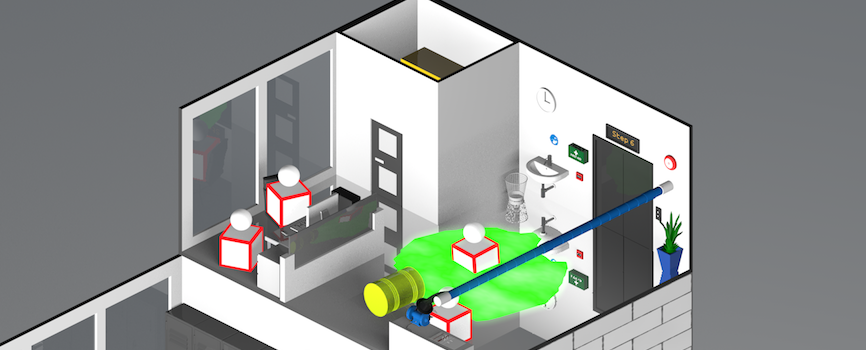Why nutrition and hydration in care homes matters
Posted 5 months ago

Nutrition and hydration in care homes are huge factors in your duty of care to patients. For anybody, the food and drink that an individual consumes has a massive bearing on mood, weight, and physical and mental health. A balanced diet with the right nutrition helps general wellbeing, and for elderly patients in care, the need for nutrition and hydration is much greater.
The NHS states that 35% of patients admitted to care homes will suffer from malnourishment. Many patients may already be malnourished when they arrive at your care business. Therefore you and your staff should be well-equipped to provide adequate nutrition and hydration in care homes as part of your care. Residents will depend on you to provide nutrition in care homes, through the meals and drinks provided, and assistance with eating and drinking too.
If you need a refresher on the different strategies you can use to maintain nutrition in care homes, then don’t worry, we’ve covered everything for you in our blog post.
What is meant by the term ‘malnourishment’?
If somebody is classed as malnourished, then they are not obtaining the minimum amount of nutrients to support growth and health. It’s important to note that malnourishment isn’t just a byproduct of undereating. An individual may be malnourished because they aren’t eating the correct foods to provide them with the nutrients they require.
If somebody is malnourished they tend to lose weight, and for care residents, this comes with a heightened risk. The NHS says that a person is classed as suffering from malnutrition if:
- They lose 5-10% of their body weight within 3-6 months unintentionally
- The Body Mass Index (BMI) of the person drops below 18.5
- Items of clothing become looser over time when worn
What are the other symptoms of malnutrition?
Aside from weight loss, there are several symptoms to look out for to spot if somebody is suffering from malnutrition. These include:
- Loss of appetite
- Feelings of muscle weakness
- Increased fatigue and tiredness
- Inability to concentrate
- Getting ill often and taking longer to recover
- Low energy levels
- Depression and low mood
- Regularly feeling cold
- Wounds take a long time to heal
As care providers, it’s essential that your staff can recognise the signs of malnutrition. As it can occur gradually, the signs may not always be apparent immediately. Physical symptoms like weight loss may take time to show. To stay on top of this, you should monitor dietary intake for patients and conduct regular weight checks as part of your care.
Poor nutrition in elderly care can be from a series of causes. It can be down to medication, forgetting to eat, being unwilling to eat, or even physical challenges, such as dental problems or dentures.
Other health issues may contribute towards malnutrition. Due to ill health, some residents may need assistance with cutting up food and eating. If you have to assist a resident with eating, then you can monitor their intake, but also there can be times when a resident is reluctant to eat with assistance. Therefore, it’s important to know exactly what good nutrition is so you can provide the right level of care you need.
What is good nutrition?
We all need a healthy level of nutrition to keep fit, both physically and mentally. For older patients in care, the need to keep hydrated and eat the right foods increases. Elderly people undergo body changes in the later stages of life which means energy levels can be obtained without the need for the same amount of calories or food that someone younger may require.
Although elderly residents may require less food, finding the right balance of nutrients in smaller meals is key.
The catering provided at your care business should reflect a healthy, nutritious diet. Good nutrition includes elements from all key food groups, and the food provided should offer a selection of balanced meal options. This should include fruits and vegetables, proteins, carbohydrates, fats and oils and dairy products. Lean meats and whole grains should be used rather than fattier meats and poor-quality produce that is higher in fats and sugars.
Foods that contain high amounts of saturated fat and salt should be avoided, to stave off any increased risk of health conditions prevalent in elderly people such as heart disease and high blood pressure.
How to prevent malnutrition and dehydration
Being vigilant is important to ensure malnutrition is prevented. Often, many elderly people in care suffer from more than one medical condition. Malnourishment can exacerbate the impact of other medical conditions, such as high blood pressure, diabetes or asthma. So, not only can malnutrition or dehydration provide unpleasant symptoms for the affected person, but it can also further complicate existing health issues.
Offering the nutritious food and hydration that elderly people in care settings require seems simple, right? Well, surprisingly, NHS guidance states that many care providers are still not satisfying the adequate standards for nutrition and hydration in care homes.
Issues around malnutrition extend beyond care home settings, costing the NHS an estimated £23.5 billion per year in the UK. It’s why managing nutrition and hydration in care homes doesn’t just mean protecting those under your care, it helps ease the stress and burden on an overstretched health service too.
Fluid charts in care homes
Preventing dehydration should be a top priority for any care provider, and the measures you can take are simple. A fluid chart is a common method used in care homes to monitor if a resident with an increased risk is getting the desired amount of water to stay hydrated. Fluid charts are used in care homes to identify reasons why an individual isn’t drinking enough, highlighting factors such as the type of drink consumed, access, timings, mood and health, illness and forgetfulness.
Providing good nutrition
So, what actions can you take to ensure nutrition and hydration in your care home is prioritised? Well, you’ll know that residents in care home settings are frail and vulnerable, therefore there is a greater reliance on care staff to provide adequate nutrition and hydration.
Regular assessments of nutritional status and hydration needs should be carried out. Are there any changes in dietary requirements? For example, are there some foods that an individual may be unable to consume and therefore adjustments need to be made? Providing good nutrition means being aware and observant of any physical changes that may be cause for concern. This should also factor in likes and dislikes, allergies and any additional support a resident may need.
The Health and Social Care Act 2008 (Regulated Activities) Regulations 2014
Staying compliant with legal requirements is always important. For nutrition and hydration, the Care Quality Commission sets out that care providers must meet the standards outlined in the Health and Social Care Act 2008 (Regulated Activities) Regulations 2014.
The regulation was introduced to provide assurances to care home residents and family members that there is adequate nutrition and hydration to sustain life and good health, reducing the risks of malnutrition and dehydration during care and treatment.
As a responsible care provider, it is your duty of care to ensure there are adequate provisions of food and drink that meet the nutritional and hydration needs of all residents under your care. Each case should be taken on an individual basis, where nutritional needs are assessed and the right meals provided to meet those needs.
The full regulation states that:
- All nutrition and hydration needs of service users must be met, where the care or treatment involves the provision of accommodation by the service provider.
- Nutritional and hydration needs for service users are offered as part of the predetermined care arrangements provided by the service provider.
- Providers must include people’s nutrition and hydration needs when they make an initial assessment of their care, treatment and support needs and during ongoing reviews, which should consider people’s nutritional and hydration needs.
- Receipt by a service user of suitable and nutritious food and hydration which is adequate to sustain life and good health,
- Receipt by a service user of parenteral nutrition and dietary supplements when prescribed by a health care professional,
- The meeting of any reasonable requirements of a service user for food and hydration arising from the service user’s preferences or their religious or cultural background, and if necessary, support for a service user to eat or drink.
Nutrition and hydration policy in care homes
Each care provider should set out their nutrition and hydration policy, and it should align with the guidance set out in the Health and Social Care Act Regulations.
A nutrition and hydration policy in a care home should include:
- Ensure any nutrition and hydration assessment is carried out by a qualified staff member. All assessments should highlight any dietary intolerance, or allergies, and how to support the health of service users through appropriate and sufficient quantities of food and drink.
- Review nutrition and hydration needs and make the necessary adjustments in good time.
- Nutritious foods should be readily available to meet the needs of all service users. This should be served at a safe temperature that is suitable for consumption.
- Record and monitor nutrition and hydration intake to prevent unnecessary dehydration, weight loss or weight gain.
- Prompts, encouragement and helpful assistance to ensure food is eaten should be provided for those in need.
- Appropriate action should be taken to address any issues with service users who are not getting the requisite nutrition and hydration in their diet.
- Water provisions should be available at all times, and alternative drinks should be made readily available to encourage service users to drink enough each day.
- For any service user who needs assistance, appropriate equipment and tools should be provided to assist with eating and drinking.
Stay on top of care home nutrition guidelines with our help
Now that we’ve explored how to deal with nutrition and hydration in care homes, we’re here to tell you about our range of interactive training courses that can help get you up to speed.
Here at iHasco, we offer an online Fluids and Nutrition in Care Homes Training course that can help your staff gain a greater understanding of nutrition and hydration in care homes.
We also offer a range of food hygiene courses to help your staff get to grips with everything around food safety. Our bundle of courses includes:
- Level 1 Food Hygiene Course
- Level 2 Food Hygiene Course
- Level 3 Food Hygiene Course
- Food Allergy Awareness Training
Each of these courses can be completed online in an average of 30 minutes and provide a printable certificate upon completion to help your care business demonstrate compliance.
Interested in learning more about these courses? You can claim a free, no-obligation trial today and check them out for yourself! Alternatively, why not request a bespoke quote and speak to our team about your unique training requirements?

Jack Rosier
Senior Marketing Executive
Related articles



Opt-in to our newsletter
Receive industry news & offers